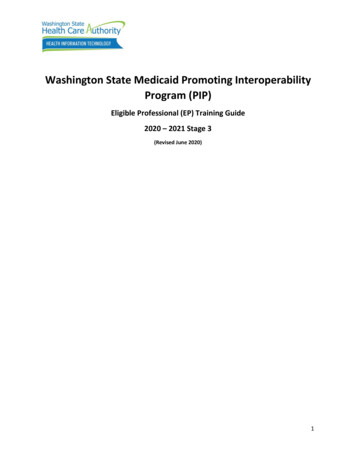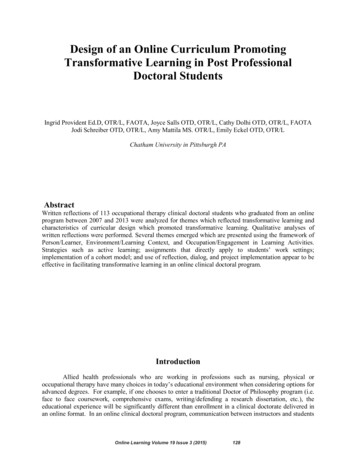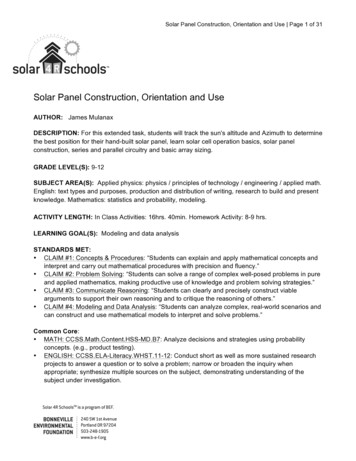
Transcription
Promoting the Use of SolarCooling and Heating in Australianbuildings (PUSCH)An Industry RoadmapMarch 2018Project partners:
AUTHORSACKNOWLEDGEMENTSMarc Sheldon (Coolgaia Pty Ltd),Subbu Sethuvenkatraman (CSIRO),Mark Goldsworthy (CSIRO)The authors acknowledge the support from the PUSCHproject partner AIRAH in preparation of inputs for thisroadmap and organisation of steering group meetings.This work is copyright. It may be reproduced in whole orpart for study or training purposes, subject to the inclusionof an acknowledgement of the source and no commercialusage or sale. Reproduction for purposes other than thoselisted above requires the written permission of the authors.The authors acknowledge the financial supportreceived from the Australian Government throughthe Australian Renewable Energy Agency.While reasonable efforts have been made to ensure thatthe contents of this publication are factually correct, theauthors do not accept responsibility for the accuracy orcompleteness of the contents, and shall not be liable for anyloss or damage that may be occasioned directly or indirectlythrough the use of, or reliance on, the contents of thispublication.The authors would also like to acknowledge the workof the steering group and experts for reviewing theroadmap and suggesting changes and inputs.Furthermore, the authors are extremely grateful tothe members of industry, research and governmentorganisations that attended the stakeholders’workshop that was a vital source of informationand industry engagement for this project.
ContentsExecutive Summary.11Introduction. 41.1Background . 41.2Motivation. 61.3Solar heating and cooling market uptake. 71.4Scope and objectives of the roadmap. 82 Solar heating and cooling – Global market overview. 102.1Market overview Asia.122.2Market overview Europe. 143 Technology benefits and opportunities.153.13.2Technology overview.173.1.1Solar heat for buildings. 173.1.2Solar cooling for buildings.18Technology opportunities. 204 Solar heating and cooling for built environment applications in Australia:Market status and market opportunities. 244.1Solar energy for the built environment: the ecosystem in Australia.264.1.1Key policy mechanisms to support solar uptake in the built environment.264.1.2Development of standards framework.284.2Solar heating and cooling: Representative large scale operational installations. 294.3Solar heating and cooling – market opportunities. 304.44.3.1Residential sector.304.3.2Commercial sector. 314.3.3Suitability of SHC solutions for various built environment types. 32Solar heating and cooling – operational benefits. 344.4.1Solar hot water systems.344.4.2Solar cooling systems.365 Solar heating and cooling – Australian market barriers. 375.1.1Initial cost. 375.1.2Lack of awareness of benefits & unrealistic expectations. 375.1.3Supply chain and workforce competitiveness. 375.1.4Technical and financial risks.385.1.5Split incentives.38An Industry Roadmapi
6 Recommendations & Next steps. 396.1Develop - standardisation & best practice designs. 406.2Support.416.2.1Energy Performance Contracting (EPC) through Energy Services Companies (ESCOs). 416.2.2Environmental Upgrade Agreement (EUA). 416.2.3On-bill finance. 436.3Implement – Exemplar projects with guaranteed performance. 436.4Inform – Training & upskilling. 446.5Next steps. 446.6Impact .477 Summary .488 Appendix I – Solar cooling and heating technologies: an overview.518.1Solar cooling.518.2Solar heating technologies. 548.3Solar combi systems. 549 Appendix II – Cost saving benefits of solar heating and cooling systems. 5510 Appendix III – Barriers. 5711 References. 58iiPromoting the Use of Solar Cooling and Heating in Australian buildings (PUSCH)
FiguresFigure 1.Commercial buildings’ total energy use trend and growth in building stock (DCCEE 2012),relative to 2009 numbers. 4Figure 2.Residential electricity price growth forecast (source: Jacobs, 2017). 5Figure 3.Average gas price (AUD/GJ) increase projections (source: Core group, 2016). 6Figure 4.Impact of solar PV and air conditioning on daily energy consumption and peak demand (from ENA, 2014). 8Figure 5.Solar thermal heating system installations worldwide: distribution by applications(data from Weiss et al, 2017). 10Figure 6.Global solar thermal, wind power and photovoltaic capacity and market growth (Weiss et al, 2017). 11Figure 7.Market development of solar air conditioning and cooling systems (Weiss et al, 2017). 11Figure 8.New developments in solar cooling and heating systems (PV and thermal driven).Non-exhaustive data collected by IEA task 53 (Mugnier, 2017). 13Figure 9.Solar district heating and cooling worldwide; annual and cumulative deployments (Weiss et al, 2017). 14Figure 10.Average daily solar exposure (Bureau of Meteorology, 2017). 15Figure 11.Climate zones in Australia as per AS5389-2016. 16Figure 12.Annual gas saving estimates from a standard residential solar hot water system for variousclimatic zones in Australia. 17Figure 13.Daily alignment of solar availability with cooling load in a commercial building. 18Figure 14.Monthly alignment of solar availability with cooling load in a commercial building. 18Figure 16.Typical PV system size and installations per month in Australia (Australian PV Institute, 2017). 24Figure 17.Annual and cumulative residential solar thermal hot water installation details. 25Figure 18.Fuel mix of residential buildings (trend analysis carried out for 2020, DEWHA, 2008). 30Figure 19.Fuel mix of commercial buildings 2009 (DCCEE, 2012). 31Figure 20.Office electricity end use shares 2009 (DCCEE, 2012). 31Figure 21.Payback estimates for various solar water heating systems (thermal collector size in m2, PV panelcapacity in kWp shown in the plot). 35Figure 22.Environmental Upgrade Agreement (top), on–bill finance (bottom) operational mechanisms. 42Figure 23.Implementation timeframe for recommendations. 45Figure 25.A generic solar thermal cooling system configuration (Pintaldi et al, 2015). 52Figure 26.A typical solid desiccant air conditioning system with heat recovery configuration. 52Figure 27.PV cooling system configuration examples. 53Figure 28.Typical solar hot water system configuration. 54Figure 29.Solar thermal water heating, PV – electric water heating and PV – heat pump water heatingsystem configurations. 56An Industry Roadmapiii
TablesTable 1.Motivation for installing SHC systems i
Water, Heritage and the Arts DHW Domestic Hot Water EEGO Energy Efficiency in Government Operations EPC Energy Performance Contracting ESCO Energy Services Company ESS New South Wales Energy Savings Scheme EUA Energy Upgrade Agreement GBCA Green Building Council of Australia GLS Green Lease Schedules GJ Gigajoule (10. 9. Joule) GW Gigawatt (10. 9. Watt) HHW Heating Hot Water HVAC Heating .











